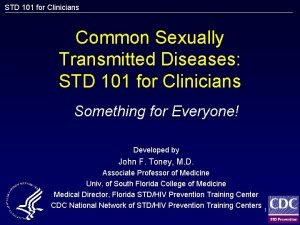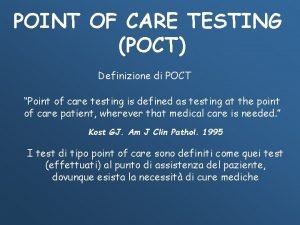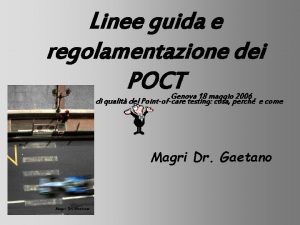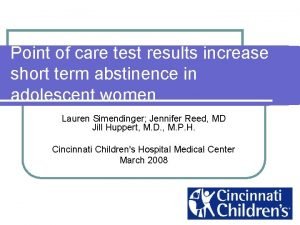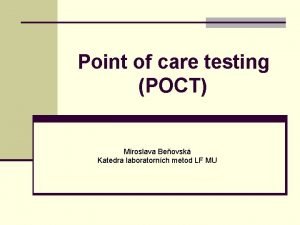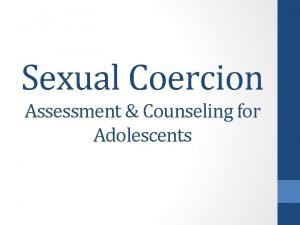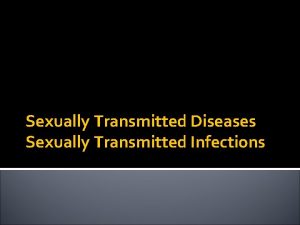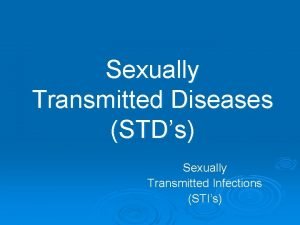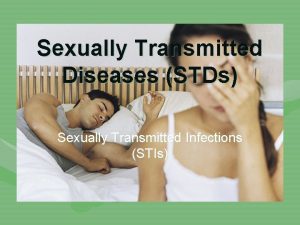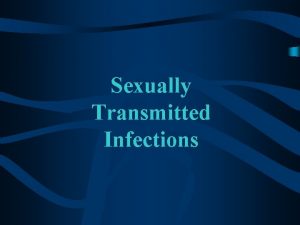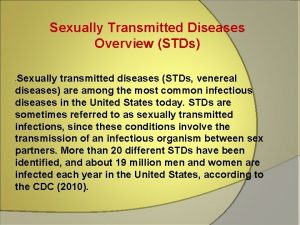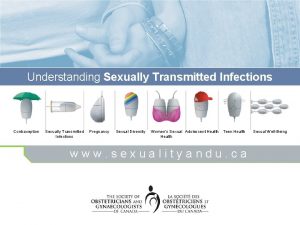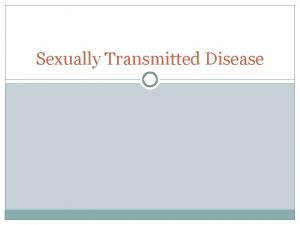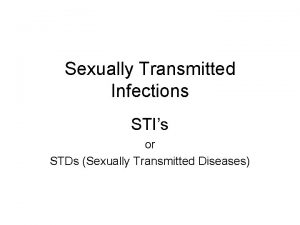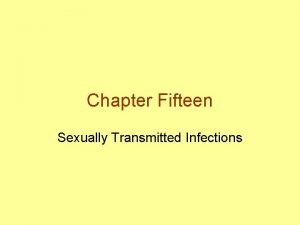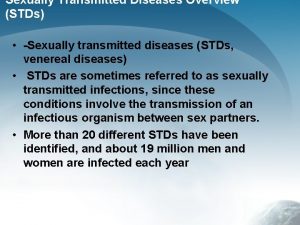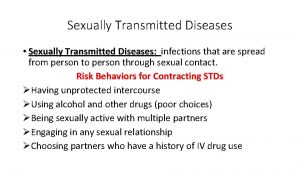Point of Care testing POCT For Sexually Transmitted























- Slides: 23

Point of Care testing (POCT) For Sexually Transmitted Infections (STI) Barbara Bewley Operations Manager Pathology Clinical Services

Pathology Clinical Services POCT Clinical Haematology Immunology Phlebotomy Ops Manager Physicians Assistants Endocrinology Diabetes

POCT for STIs • What is POCT? • Who oversees POCT? • Governance • Who performs POCT? • Hands on staff • Why POCT? • Benefits • Why POCT for STIs? • Benefits • What is available?

POCT - Definition “… any analytical test performed for a patient by a healthcare professional outside the conventional laboratory. ” “…testing that is performed near or at the site of the patient with the result leading to possible change in the care of the patient. ”

POCT Guidelines and Standards • Management and Use of IVD Point of Care Test Devices – March 2003 DB 2002(03) • Pre POCT implementation - Lab involvement – – – Clinical need Equipment choice Business Case Clinical Governance Pro’s and Con’s

POCT Guidelines and Standards – DB 2002(03) • Management and Organisation – – – Accountiblity SOPs, Training, Health and Safety QA (inc QC, & EQA) Maintenance, Record Keeping IT Adverse Incidents

POCT Guidelines and Standards • DB 2010(02) February 2010 – More expansive • Locations – Wider variety of hospital and community areas • Range of test examples – References Strategic Government Papers – Use of Case studies • Illustrates poor practice • Specific key learning points

POCT Guidelines and Standards • Ultimate responsibility –“The laboratory, or the parent organization of which it is a part, shall ultimately be responsible for ensuring that appropriate measures, including internal quality control and participation in EQA schemes, are in place to monitor the accuracy and quality of POCT conducted within the healthcare organization. ”

POCT Management • Team – Senior Biomedical Scientist – Band 7 – Biomedical Scientist – Band 6 – Associate Practitioners x 3 – Band 4 – Administrative Assistant • Multidisciplinary • Trust Policies • Procurement control

POCT - Locations and Staff Groups Off Site A&E Out wards patients Other Hospitals GP surgery Consultants Nurses Anaesthetists Sp. R Midwives HCAs Student nurses ODPs PAs Pharmacy Out Reach Pharmacists Lab staff Practice staff Resp Techs COPD nurses SHO HO Medical students

POCT – Why? • Turn Around Time (TAT) for results – Analysis time – Reporting time – Transport • Benefits – Rapid changes to care and medication – A&E 4 hour target – Prevent unnecessary cancellation of appointments – Captures hard to reach clients

Quality Point of Care Testing • • Right result for Right investigation on Right specimen from Right patient at Right time in Right place using Right reference data at Right cost (? )

POCT for STIs • USA (2010) – 30 STI organisms in lead group of reportable diseases – >19 million new cases per year – Cost of 9. 3 – 15. 5 million dollars – Lab TAT 2 – 14 days • Contributed to low pt return rates • Re infection of presenting patients • On going transmission of infection

POCT for STIs • Ideal POCT for STI – Immediate diagnosis and treatment in a single visit – Address some of STI control needs

POCT for STIs • Barriers – Complexity – Time – multiple time driven steps – Difficulty reading results – Interruption of workflow – Unreliability – Invasiveness

POCT for STIs • The WHO Sexually Transmitted Diseases Diagnostic Initiative coined the term ASSURED to define the criteria for a POCT for STIs in a resource limited setting.

ASSURED – WHO Criteria • • Affordable Sensitive Specific User friendly Rapid & Robust Equipment free Delivered An ASSURED test that is less sensitive than a lab test might result in more infected people receiving treatment

POCT for STIs • Applicable to other settings: – Access and confidentiality – Community based services – Improve low return rates for results – Reduction in mental stress for returners – Transient populations – Hard to reach communities

Current examples of POCT for STIs • STI’s– – chlamydia, gonorrhea, syphilis, HIV

Future POCT for STIs • Bio. MEMS – Microfluidics allowing miniaturisation of complex reaction processes • PCR – Smaller equipment & sample size – Faster processing

POCT for STIs • What is POCT? • defined • Who oversees POCT? • POC team/appropriate lab • Who performs POCT? • Clinical staff • Why POCT? • TAT, quicker changes to care/ medication • improved patient care • Reduction in cancelled appointments

POCT for STIs • Why POCT for STIs? – Effectively treat more people with STIs • Single visit diagnosis and treatment initiation • Infection control strategy = risk reduction • What is available? • Increasing number of manufacturers • Increasing range of products • Remember the WHO ASSURED criteria – Not lab quality but must meet minimum criteria

Thank you
 Chapter 24 lesson 1 sexually transmitted diseases
Chapter 24 lesson 1 sexually transmitted diseases A bacterial std that usually affects mucous membranes
A bacterial std that usually affects mucous membranes Chapter 24 sexually transmitted diseases and hiv/aids
Chapter 24 sexually transmitted diseases and hiv/aids Sexually transmitted diseases
Sexually transmitted diseases Nursing management of reproductive tract infection
Nursing management of reproductive tract infection Std
Std Poct esempi
Poct esempi Elektron poçt
Elektron poçt Linee guida poct
Linee guida poct Poct
Poct Abg poct
Abg poct Poct přístroje
Poct přístroje Göyərçin poçt quşu rolunda
Göyərçin poçt quşu rolunda Types of care primary secondary tertiary
Types of care primary secondary tertiary Whale phylum
Whale phylum Annelida and nematoda
Annelida and nematoda Spider phylum
Spider phylum Unokais
Unokais What is coercion
What is coercion Protist reproduction
Protist reproduction Sexual abuse awareness training quiz answers
Sexual abuse awareness training quiz answers Sea cucumber anatomy
Sea cucumber anatomy Protists habitat
Protists habitat Define arouse sexually
Define arouse sexually





